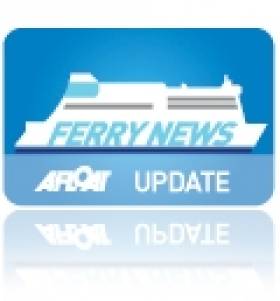Displaying items by tag: DouglasHeysham
The Isle of Man Steam Packet Company has suspended overnight ferry sailings on the Douglas-Heysham route, the operator's main service until ropax Ben-my-Chree returns from scheduled repairs on Merseyside.
According to BBC News, crossings during the morning from the Isle of Man to England and those returning from the port in Lancashire in the afternoon are now being operated by their fastcraft Manannan until 31 March.
The catamaran craft which can carry 865 passengers and 200 cars, has undergone the biggest refit since entering service in 2009 with significant investment to customer service areas.
As for the scheduled repairs to the Steam-Packet's 1998 custom-built Ben-my-Chree, they are currently been carried out at Cammell Laird in Birkenhead, though originally they were due to take place after the TT in June but were brought forward.
The company's relief ro-ro freight ferry Arrow, Afloat tracked last week on a passage from Scotland to the Isle of Man. This follows a charter to CalMac between Ullapool and Stornaway on the Isle of Lewis due to the related closure of Uig Harbour on Skye.
The return of the 84 trailer capacity Arrow sees freight runs provided between the Manx capital and Heysham along with passenger services by Manannan.
The decision to bring forward the dry-docking of Ben-my-Chree with the scheduled repairs, is according to the Steam Packet to alleviate any pressure on schedules with the arrival from Asia of the newbuild ferry Manxman.
It was during sea trials that a gearbox fault was found of the £78m ferry built in South Korea which is to replace Ben-My-Chree as the main ferry on the operator's only year-round route.
#ManxFerry&Freight – Isle of Man Steam Packet ro-pax ferry Ben-My-Chree is undergoing a biannual overhaul, in her place on the Douglas-Heyham route are fast-ferry Manannan and Arrow providing freight capacity, writes Jehan Ashmore.
Work on Ben-My-Chree at Cammel Laird, Birkenhead, will include refurbishment of some of her passenger lounges, with additional seating added to the Cafe Bar. Investment to interior changes are to refresh passenger areas and improve customer experience.
The 'Ben' is scheduled for a three week dry-docking period and is expected to return to service in time for the annual TT Races starting on 24 May.
Arrow which recently began a long-term charter, has a 65-unit capacity that will provide a lifeline for the island. She represents a multi-million pound investment and effectively is an insurance policy, allowing the operator flexibility to plan for scheduled maintenance periods and if required enhanced level of backup.
The Steam Packet's Chief Executive Mark Woodward said, "It allows us to supplement Ben-my-Chree and Manannan during the TT period, and at other times of peak demand to allow extra capacity for passenger vehicles".
"Already this year, the additional freight capacity offered by MV Arrow has released space on Ben-my-Chree and helped boost TT2014 bookings, which at the end of March indicated that motorcycle bookings were up by 6% on TT2013, cars, vans and trailers were up by 5% and passengers up by 4%".
The 7,606grt Arrow which is chartered from Seatruck Ferries with an option for the Steam Packet to purchase the vessel. During periods not in use, she will go to lay-by in an Irish Sea port yet made available at short notice.
Plans for Wind-Farms Won’t Affect Manx Ferry Operator
#MANX FERRY – The IOM Today reports that the Manx Government is drawing up plans to ensure that any wind-farms built within the waters off the island would not affect ferry routes.
Work on the Isle of Man Marine Plan is under way and the Department of Environment, Food and Agriculture's director of environment Martin Hall said it was important it was completed in a 'timely manner'.
One of the plan's objectives would be to identify current activities in Manx waters and safeguard their ongoing use. Mapping the location of navigation corridors, important natural areas and pipelines/cables will enable the island to identify potential wind farm sites that will not adversely affect current uses of the Manx marine environment, including ferry routes and fishing.
The comments come following criticism from the Isle of Man Steam Packet Company over Centrica's plans for a wind farm in the Irish Sea, outside Manx waters. The Steam Packet says that Centrica plans to develop in the path of two routes: Douglas-Liverpool and Douglas-Heysham, in spite of complaints from the ferry operator. For much more on this story click HERE.































































